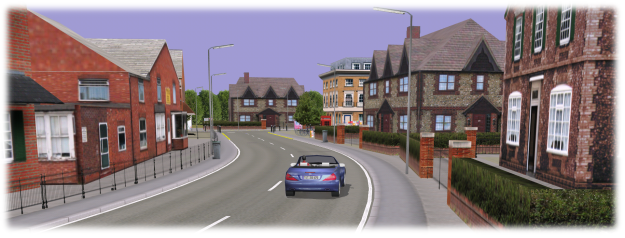In the last blog articles of our “Data for all” series, we’ve looked at standards that define how different, navigation-related kinds of data can be shared on the road – between vehicles, amongst ECUs or sensors, or with different manufacturers, suppliers, data providers or authorities. But before any car can hit the road, it needs to be thoroughly tested for all eventualities. Now, this can mean that engineers drive around in cars adorned with roughly hewn sheets of metal, or camouflaged with fancy swirls in black and white, but more often, it comes down to simulations – and lots of it. This is where the ASAM OpenDRIVE specification comes into play.
The OpenDRIVE data format specification contains definitions for all static objects of a road network that allow realistic simulation of vehicles driving on roads. Its main goal is the facilitation of data exchange between different driving simulators. Unlike other file formats, the description is typically used for simulation applications. The data describes the exact road geometry, including surface properties, markings, signposting, and logical properties such as lane types and directions. Dynamic entities like cars, bikes, or pedestrians are not included.
The data may be derived from manually created road networks, conversion of real-world map data, or data collected of real-world roads. The basic principle for describing a road segment in OpenDRIVE is to first define a reference line (aka anchor line or road center line) and then attach various attributes to it. The result is a precise 3-dimensional road definition.

The NDS Association member companies decided to develop a data conversion tool for OpenDRIVE to support simulation activities of its members. The NDS converter can transcode NDS data into OpenDRIVE and vice versa. Because drive simulations can be helpful in a number of situations. For example, Electronic Control Units (ECU) running with NDS map data can be simulated with environment and traffic simulation tools that require the same map data in OpenDRIVE format. With the converter, real-world situations can be made available for simulation during the development process by converting an NDS map to OpenDRIVE. Edge cases for the ECU’s operation can be modelled in the format and tested on the ECU by converting that map to NDS. The converter, which currently supports NDS version 2.5.4 and OpenDRIVE 1.5, is regularly updated with new scenarios.
The OpenDRIVE initiative was initially started in 2005 by Daimler Driving Simulator and VIRES Simulationstechnologie GmbH to describe entire road networks. When the initiative was published in 2006 other companies joined in which lead to the transfer of OpenDRIVE to ASAM in 2018. ASAM (Association for Standardization of Automation and Measuring Systems) is a non-profit organization that promotes standardization for tool chains in automotive development and testing.
OpenDRIVE consists of a core expert team that reviews and releases the standard. The team also includes representatives from BMW Forschung und Technik GmbH, DLR e.V. and Fraunhofer-Institut IVI, amongst others.
For more information, visit https://www.asam.net/standards/detail/opendrive/
Back to news →